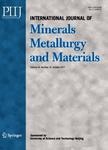Temperature distribution and dynamic control of secondary cooling in slab continuous casting
Temperature distribution and dynamic control of secondary cooling in slab continuous casting作者机构:School of Materials Science and Engineering Dalian University of Technology Dalian 116023 China Anshan Iron and Steel Group Anshan 114021 China Department of Mechanical Engineering Tsinghua University Beijing 100084 China
出 版 物:《International Journal of Minerals,Metallurgy and Materials》 (矿物冶金与材料学报(英文版))
年 卷 期:2009年第16卷第6期
页 面:626-631页
核心收录:
学科分类:080602[工学-钢铁冶金] 080503[工学-材料加工工程] 08[工学] 0806[工学-冶金工程] 0805[工学-材料科学与工程(可授工学、理学学位)] 0802[工学-机械工程] 080201[工学-机械制造及其自动化]
基 金:supported by the National Natural Science Foundation of China (No.50174031)
主 题:mathematical model slab temperature dynamic control continuous casting
摘 要:To predict and optimize the temperature distribution of slab continuous casting in steady operational state, a three-dimensional model (named "offline model") based on the heat transfer and solidification theories was developed. Both heat transfer and flux distribution characteristics of the nozzle sprays on the slab were considered, and the complicated boundary conditions, such as spray cooling, natural convection, thermal radiation as well as contact cooling of individual rolls were involved in the model. By using the calibrated caster dependent model factors, the calculated temperature and shell thickness accorded well with the measured. Furthermore, a dynamic secondary water cooling control system was also developed on the basis of a two-dimensional transient heat transfer model (named "online model") and incremental PID control algorithm to reduce slab surface temperature fluctuation in unsteady state. Compared with the traditional spray table control method, the present online model and dynamic PID control demonstrate a higher capability and flexibility to adjust cooling water flowrate and reduce slab surface temperature fluctuation when the casting speed is changed.



